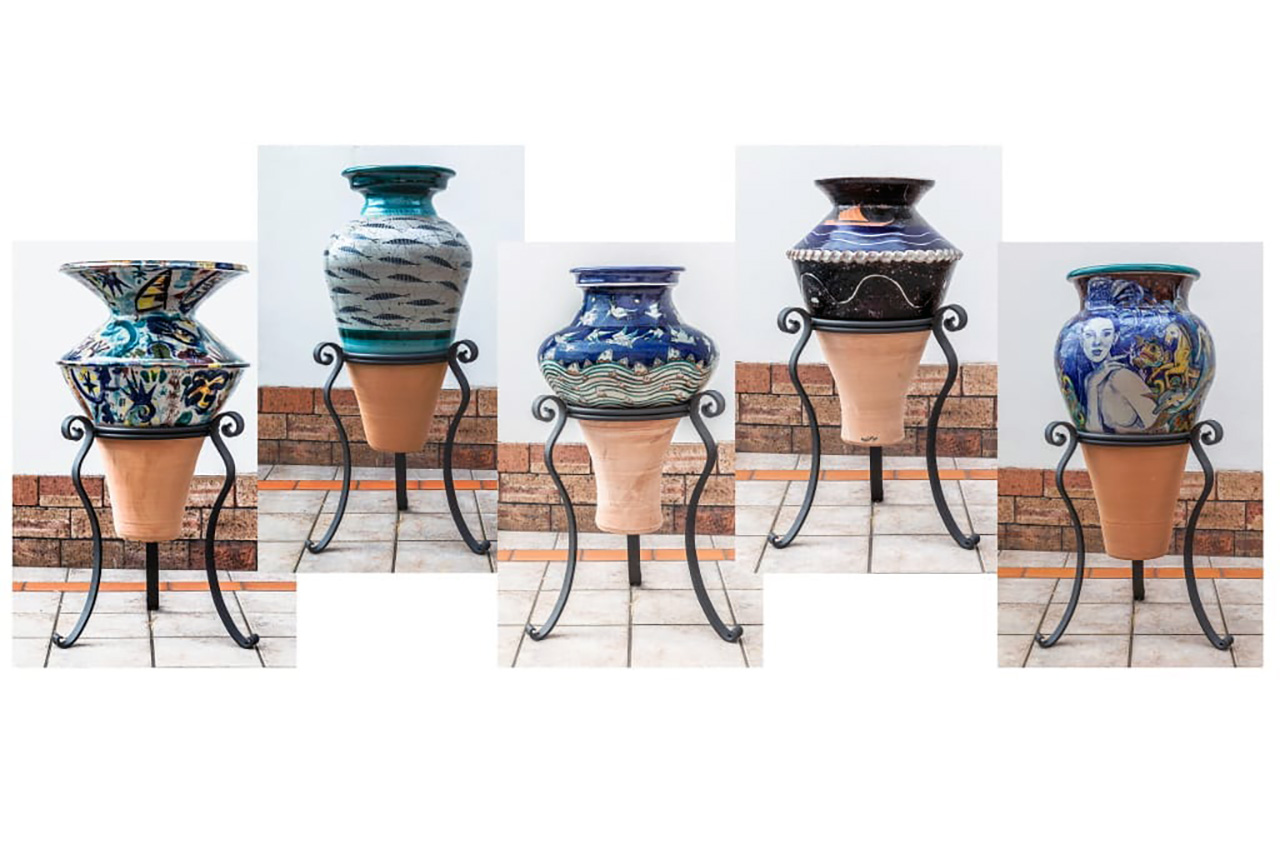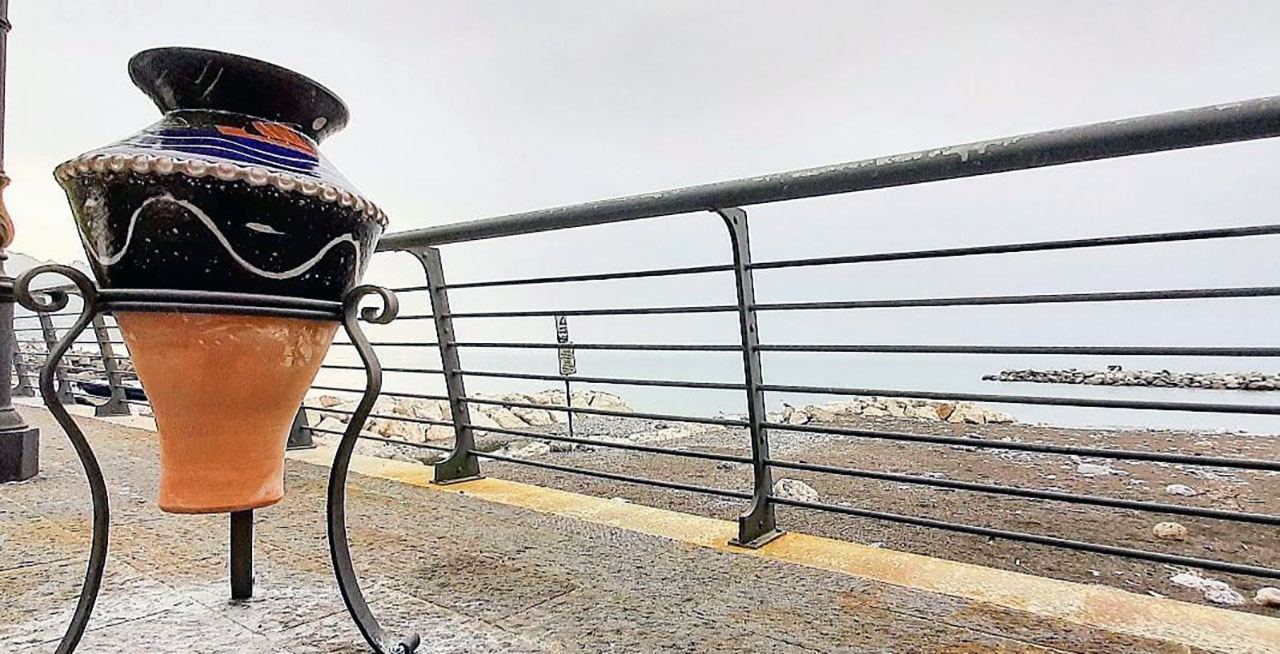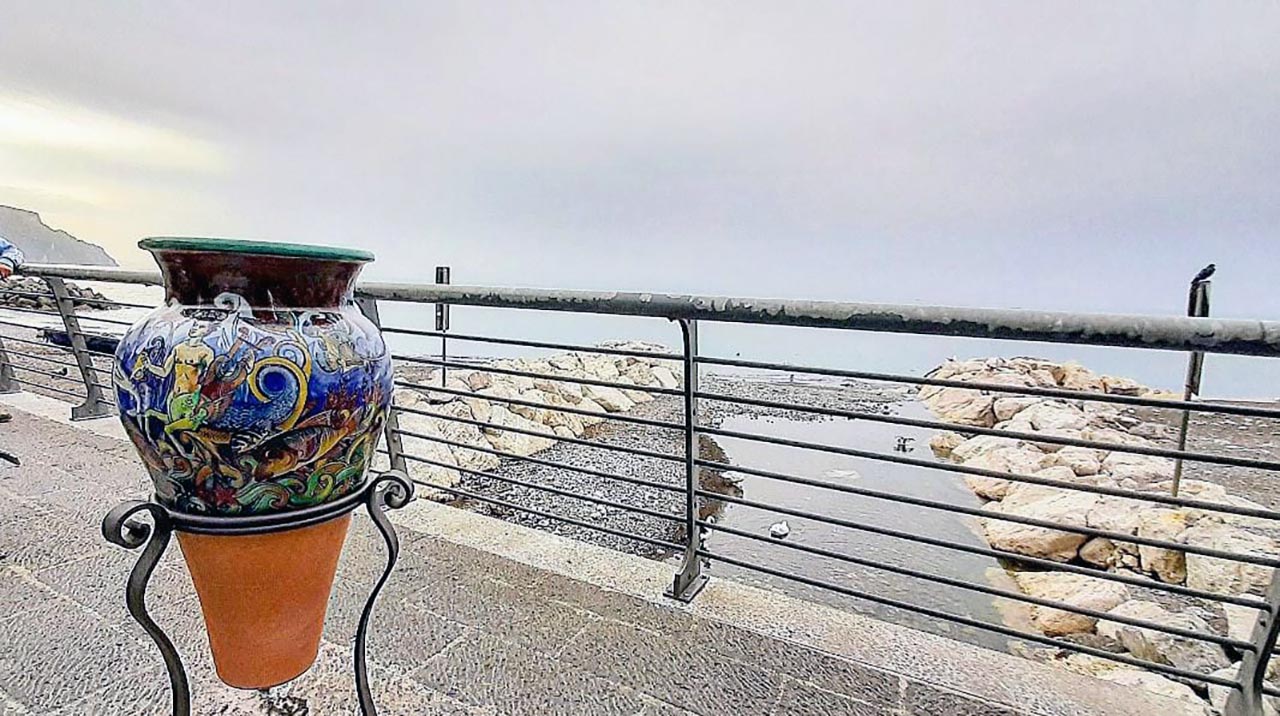On Largo Marinella in Atrani, some works celebrate the local fishing culture and the link with the sea
May 30th, 2021.By Annamaria Parlato
The relationship between man and sea represents an ancestral link that has persisted since the dawn of civilization. The dreamlike dimension of the sea depths, full of solid references, makes the salty waters refer to the origins of the world and existence itself, which is part of each of us in an almost paradigmatic way.
The agreement between the FLAG and the Municipality of Atrani
In January 2021, the Local Action Group in the fishing sector “FLAG APPRODO DI ULISSE” based in Cetara and the Municipality of Atrani signed an exciting agreement. The Ulysses Approdo FLAG was created to promote and support small-scale coastal fishing and related activities through a critical interpretation that interacts with the seafarers’ history, tradition, and culture.
This agreement had as its object implementing the intervention “Promotion campaigns for the enhancement of local fish, of the traditions of the FLAG maritime industries.” The action was aimed exclusively at Local Authorities included in the FLAG territory. They implemented it with a procedure that started after the preliminary approval by the Campania Region, through the publication of an expression of interest addressed to the Municipalities.
The voice of the sea
The action aimed to enhance the image of the fishing economy, of the maritime and productive traditions of the territory of the Ulysses Landing FLAG, strengthening the link between the environment (marine and coastal), cultural/traditional capital, coastal fishing operators, consumer awareness of the fish resource and local community. These objectives were necessarily associated with the themes of the protection and safeguarding of the sea resource and the environment and actions that support the fight against illegal fishing.
And so the “Vasi d’a…mare” project was born, coordinated by the gallery owner and curator Gennaro Mangieri, to promote, among other things, cultural and artistic events related to the theme of fishing and the sea. The project enhances the link with the maritime traditions and, at the same time, with the creative and traditional activities of the villages.
The President of FLAG, Fortunato Della Monica, admitted: “All this took place to strengthen the visibility, credibility, and image of the territory through the concept of fishing as a compatible activity, highlighting the effort that the sector has done and continues to do to overcome obstacles and problems to get out of marginality and to act as a valid competitive sector of coastal fishing. It enhances the connection between the maritime traditions of the villages and the art and craft activities traditions and identity of the FLAG territory. ”

A museum en plein air
An ancient bond unites the small town to “its” sea, a bond that starts from the times when the history of Atrani is closely intertwined with that of Amalfi and the ancient maritime republic. The Atranienses prospered thanks to their commercial initiative and facing the incursions of the Pisans in the 12th century. The 1343 tsunami submerged a large part of the coast. The fascination of the lampara and the fishing of the second half of the last century reached the tourist development of today.
The works of Lucio Liguori (A sea of anchovies) are dedicated to this link; Francesco Raimondi (Sirens of Atrani); Vincenzo Caruso (Backdrops); Sasà Mautone (Long Wave); Pasquale Liguori (Blue infinity), installed on hand-shaped supports by the artist-blacksmith Giovanni Spada and placed en plein air on Largo Marinella on April 29th.
The Mayor Luciano de Rosa Laderchi proud of having given life to a museum of contemporary art, albeit in an embryonic form, in the natural museum of the sea, which is the village of Atrani, enormously pleased, underlined his satisfaction: “I thank the group of local action in the fishing sector Flag and its President, Fortunato Delle Monica, who have allowed the realization of the Amare Nostrum project – a project of sea vessels to promote, among other things, cultural events and artistic activities related to the theme of fishing and the sea, enhance the link with maritime traditions and, at the same time, with the artistic and traditional activities of the villages. A heartfelt thanks to my friend Rino Mangieri, who coordinated this initiative to promote and enhance the area, encouraging quality cultural tourism. And, of course, thanks to the five artists who with their extraordinary works help us once again to make “Atrani open-air museum” more and more”.
The author’s vases
The source of inspiration that unites the artists is the sea with all its natural elements that characterize both the intense color between the real and the mythological and the enameling process of the works. The styles and techniques of each artist, dictated by the training and life path, have shaped the sculptures in a crescendo of metaphorical virtuosity: it seemed to see and touch the vortex of the intense colors of the sea, the sky, the beaches.
Of the woods, of citrus groves, of lemons, submerging the viewer with emotions and making “… sweet shipwreck in this sea”. The artistic expressions of the five master potters contemplated the ability to revive the stories of those fishermen who every day embarked on their small boats in search of fortune.
Enzo Caruso – Backdrops
Enzo Caruso taught ceramic design from 1963 to 1996 at the State Institute of Art Filiberto Menna in Salerno. In 1975 he was one of the founders, in Salerno, of the Fornelle laboratory, where he made ceramics inspired by the Vietrese archetype. He currently has a workshop in Vietri Sul Mare, where he creates unique pieces and ceramic sculptures. Over time, his technical experimentation has particularly insisted on the material effects of glazes, working on dosages, compositions, and different melting temperatures.
Like other artists of the Amalfi Coast, Caruso has also been careful for years to weave a dialogue with ceramics, that is, a relationship with the manual skills, the colors, the imagery of famous and archaic Mediterranean ceramics. Caruso’s ceramics, in particular, made imperfection a virtue. Rino Mangieri, describing Caruso’s work, highlighted: “The design and construction of the work suggest efficiency and order. And it is only in the context of the smoothness of our society that the luxury of imperfection can be forgiven”.
Lucio Liguori – A sea of anchovies
Lucio Liguori, a prominent exponent of a well-known craftsman family, was born in 1958 in Vietri Sul Mare, graduated from the Art School of Salerno, trained through many internships in Vietri ceramic workshops opened his atelier in Raito.
In 1979 he won the National Travel Award through Vietri Sul Mare ceramics, and in 2000 he participated in the International Biennial of Ceramics in Vallauris. He is invited to artist residencies, exhibitions, and competitions in Sweden, Belgium, Greece, Tunisia, France, Portugal, and Italy, in Albisola, Cerreto Sannita, Deruta, Faenza, Grottaglie, Lodi, San Lorenzello, Santo Stefano di Camastra. Constant experimenter both in the shaping and decoration of his works, he introduced the raku technique to Vietri.
He enriched the local iconographic heritage by renewing the “German” figurative tradition and proposing abstract-geometric ornamentation based on the masters of Escher and Guido Gambone. To the question: “What does the sea represent for the human being?”, The master replied: “Simple: the sea is his past, the sea is his present, the sea is his life, that is the future of him. I look at all that our sea has to offer, and that inspires me every day. I also observe the celestial dimension and its constellations, that space-time vastness that has always fascinated me ».

Pasquale Liguori – Infinite blue
He lives and works in Raito di Vietri Sul Mare. He begins very young to learn the techniques of pottery both on the lathe and in decoration. Since 1975 with rudimentary means, he chopped the components to experiment with glazes. Thanks to his continuous research, he perfected glazes of different characteristics and managed to obtain metallic lusters applications, results that make his works unique.
He has participated in numerous national and international exhibitions. Some pieces are present in many national museums and international museums, such as Museo Cargaleiro Pòlo Castelo Branco, next to the works of Pablo Picasso, and two polychrome tiles are exhibited at the Museo Nacional do Azulejo in Lisbon (Portugal). His characters seem to come out of a fairy tale, and the artist inspects the female world in all its facets. The subjects soar in the air, swim in the sea with the fish, live experiences that every child has imagined at least once during his childhood. In his world, everything is possible, and every gesture is pure magic.
Sandro Mautone – Long wave
Sandro Mautone, born in Naples in 1950, followed his artistic studies in his hometown. At the end of the seventies, he moved to Praiano, where at the time a small community of artist friends had formed who, far from the city, sought in the silent spaces of the coast to deepen their interest in the arts. The painting, graphics, decoration concentrated a large part of the study and worked in the first phase.
Then the meeting with Alberto Sassone and ceramics took place in Amalfi. He begins to teach plastic disciplines at the Liceo Artistico of Salerno. He receives prizes and awards and sets up exhibitions. In Praiano, he participates in the Naturarte project, inserting his works in one of the paths envisaged by the project. Now he continues his research in Cava dei Tirreni, where he has lived for some years. Mautone articulates the space between simplified lines and different tonal gradations, giving it a mysterious and impalpable dimension. Nature in Mautone is silent, Arcadian, luxuriant, marked by clear and precise features placed in a classical pictorial tradition but reinterpreted in a modern key.

Francesco Raimondi – Sirens of Atrani
Francesco Raimondi was born in Vietri Sul Mare in 1959 and has always worked and lived in the splendid center of the Amalfi Coast. His laboratory “L’ Archetto” has become the reference point for all passionate lovers of ceramics. From an early age, a decorator by vocation trained in the main Vietri “faenzere,” working alongside great masters. His works are exhibited in many of the great museums worldwide and numerous private collections, including the Flicam Ceramics Museum of Fu Ping in China, the Azulejos Museum in Lisbon, the Nabeul Ceramics Museum in Tunisia, the International Museum of Ceramics of Faenza, and many others. In 2006 he won the gold medal at the Chelsea Flower Show in London with the Campania region, awarded by his majesty Queen Elizabeth.
In October 2016, he was awarded the title of “Master of Art and Craft” as one of the world’s leading exponents of Italian quality. The jury of the Milan triennial, the Cologni association, and the ALMA association have included the Master in the Golden Book of Italian Artisan Excellence. In 2018 he was awarded the honor of Knight “Merit of the Italian Republic” by the Republic Mattarella.
Tales of sightings of sea monsters are found in all cultures that have had contact with the sea—mixed with fear and fascination, the sirens highlight, symbols of the call of the sea, which with their song attracted the sailors and dragged them into the infernal abysses, where even the powers of the patron saints were ineffective. Raimondi’s sirens emanate a mysterious charm. They move in an abstract dimension but rich in cultured quotations, unscrupulously inviting the observer to be open to contamination, running the risk of being sometimes judged “grotesque” in its ambivalent meaning.

